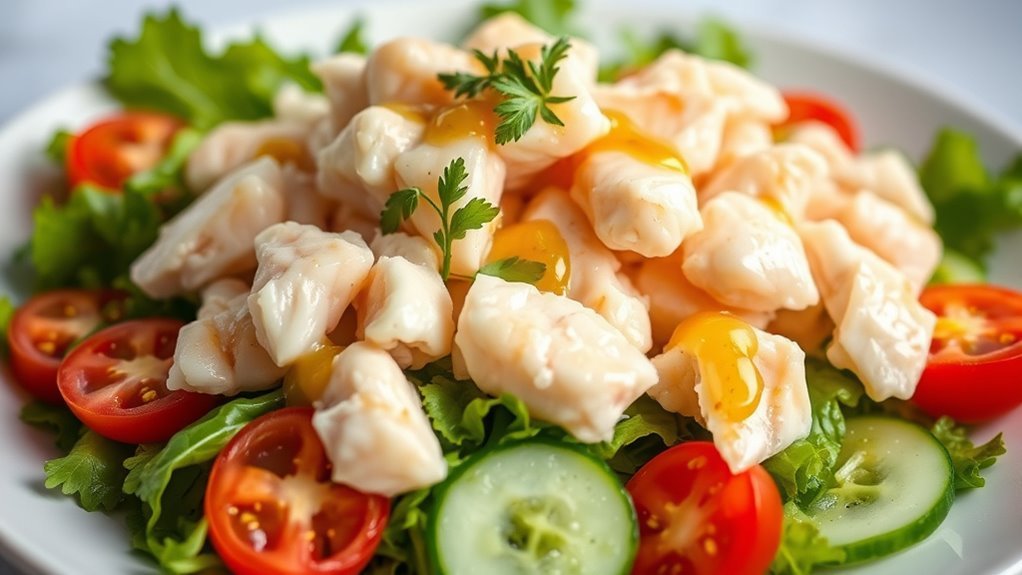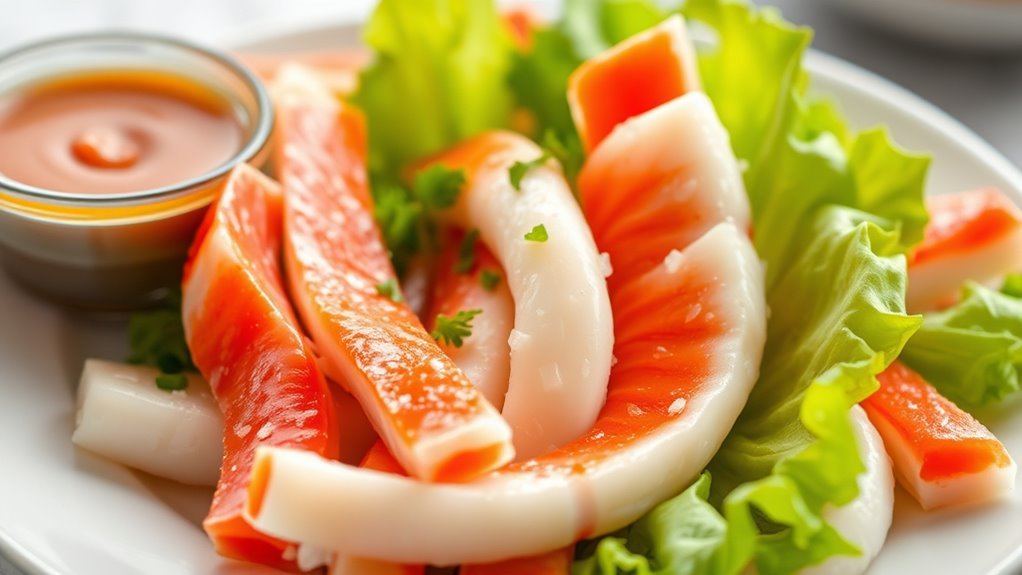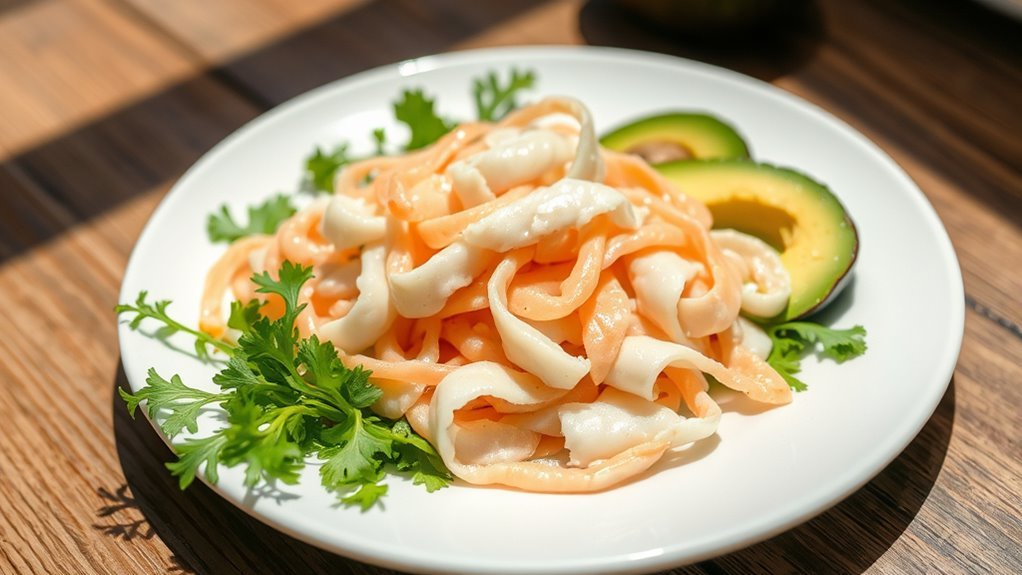Imitation crab meat isn’t the best choice if you’re following a keto diet. It contains about 12 grams of carbs per 100 grams, which can easily disrupt your daily carb limits. Plus, its protein quality is lower than real seafood. While it may be low in calories and fat, the additives and fillers can affect your health. If you’re curious about better alternatives or tips on incorporating imitation crab into your meals, there’s more to explore.
Understanding Imitation Crab Meat

Imitation crab meat, often found in sushi rolls and seafood salads, is a popular seafood alternative made primarily from surimi, which is processed fish, usually pollock. This versatile ingredient offers several culinary uses, from enhancing pasta dishes to serving as a filling in sandwiches. Its mild flavor allows it to blend well with various seasonings and sauces.
In terms of nutritional benefits, imitation crab meat is low in calories and fat, making it appealing for those watching their intake. It also provides a source of protein, which is essential for muscle maintenance and repair. However, it’s important to check for added ingredients, like artificial flavors or preservatives, that can affect its overall nutritional profile.
Nutritional Breakdown of Imitation Crab

When considering imitation crab meat as part of your diet, it’s important to examine its nutritional profile. Typically, imitation crab contains around 70-100 calories per 3-ounce serving, making it a low-calorie option. Its protein content is approximately 6-8 grams per serving, which can help support your daily protein needs. However, keep in mind that the protein in imitation crab isn’t as high-quality as that found in real crab or other seafood. This product is primarily made from surimi, a fish paste, and often includes fillers and additives. While it can be a convenient, flavorful addition to meals, always check the labels to understand what you’re consuming. Balancing your choices is key to enjoying a healthy diet.
Carb Content and Keto Compatibility

Although imitation crab meat is often marketed as a seafood alternative, its compatibility with a keto diet largely depends on its carbohydrate content. Typically, imitation crab meat contains around 12 grams of carbs per 100 grams, primarily from starches and other carb sources. This amount can hinder your ability to stay within the daily carb limit of a strict keto diet, which usually requires fewer than 20-50 grams of carbs. While it can offer some keto benefits, such as being low in calories and fat, it’s essential to take into account how its carb content fits into your overall meal plan. If you’re aiming for ketosis, monitoring your intake of imitation crab meat is vital for achieving your dietary goals.
Ingredients in Imitation Crab Meat
While it may resemble real crab meat, imitation crab is primarily made from surimi, a processed fish product derived from white fish like pollock. This fish is blended with other ingredients, including starch, egg whites, and various flavorings to enhance taste. The nutritional value of imitation crab is often lower than that of real crab meat, particularly in protein content. Ingredient sources can include artificial colors and preservatives, which may concern some consumers. It’s important to read labels carefully to understand what you’re consuming. If you’re considering imitation crab for your diet, knowing these ingredient sources will help you make informed choices. Ultimately, while it’s convenient, it’s crucial to weigh its benefits against your nutritional goals.
Health Implications of Consuming Imitation Crab
When considering imitation crab meat, it’s important to assess its nutritional content, as it often contains lower protein and higher carbohydrates than real crab. Additionally, be aware of potential allergens and additives, which can vary by brand and may affect those with shellfish allergies or sensitivities. Understanding these factors can help you make informed choices about incorporating imitation crab into your diet.
Nutritional Content Assessment
As you consider the health implications of consuming imitation crab meat, it is vital to evaluate its nutritional content. Imitation crab typically contains lower caloric value compared to real crab, making it appealing if you’re watching your intake. However, while it can serve as a protein source, the protein content is generally less than that of genuine crab meat. Instead of being a pure seafood product, imitation crab often includes surimi, starches, and fillers, which may dilute its nutritional profile. If you’re pursuing a keto diet, you might want to monitor how these ingredients fit into your overall macronutrient goals. Balancing taste and health is essential, so always check the label for specifics to make informed choices.
Potential Allergens and Additives
Although imitation crab meat can be a convenient seafood substitute, it often contains various potential allergens and additives that you should be aware of. Common allergen concerns include shellfish, wheat, and soy, which can trigger reactions in sensitive individuals. The ingredients list may also include starches and preservatives that enhance flavor and texture but could have additive effects on your health. Some additives can lead to digestive discomfort or other unwanted symptoms for certain people. If you’re following a strict keto diet or have dietary restrictions, it’s essential to read labels carefully. Prioritizing whole foods and fresh seafood can help you avoid these potential issues while ensuring a healthier, more balanced diet.
Alternatives to Imitation Crab for Keto Dieters
If you’re on a keto diet and looking for alternatives to imitation crab, there are several options that can satisfy your seafood cravings while keeping your carb count low. Here are some great substitutes:
- Canned tuna: Packed with protein and virtually no carbs, it’s versatile and can be used in salads or casseroles.
- Shrimp alternatives: Fresh or frozen shrimp can be a delicious low-carb option, rich in nutrients and flavor.
- Crab meat: Real crab is low in carbs and high in healthy fats, making it a perfect fit for keto.
- Salmon: This fatty fish is a great source of omega-3s and protein, adding richness to your meals without the carbs.
Explore these options to enjoy seafood while staying true to your diet!
Tips for Including Imitation Crab in Your Keto Meal Plan
Imitation crab can be a convenient and flavorful addition to your keto meal plan, especially when you’re looking to mix things up. To incorporate it effectively, consider using it in keto recipes like crab salad, where you can combine it with avocado and low-carb veggies for a satisfying meal. It’s also great in stir-fries or soups, providing a seafood twist without the high carbs. For meal prep, portion out imitation crab into containers with other keto-friendly ingredients, ensuring you have quick, easy meals ready to go. Just be mindful of the ingredient list, as some brands may include added sugars or fillers. This way, you can enjoy the taste of crab while staying true to your keto goals.
Frequently Asked Questions
Can Imitation Crab Meat Be Part of a Low-Carb Diet?
Imitation crab meat can definitely fit into a low-carb diet, thanks to its relatively low nutritional content. With a carb count often around 10-15 grams per serving, it’s a suitable option if you’re mindful of your overall intake. However, always check the label, as some brands can vary. Balancing it with other low-carb foods guarantees you enjoy variety while staying within your dietary goals, giving you the freedom to savor your meals.
How Is Imitation Crab Meat Made?
You might think imitation crab meat is crafted by magical sea creatures, but it’s actually a fascinating production process! Made primarily from surimi, which is fish paste, it’s blended with starch, flavorings, and sometimes coloring to mimic the taste and texture of real crab. This process guarantees it’s affordable and widely available. So, next time you enjoy imitation crab, remember it’s a clever blend of ingredients designed to delight your taste buds!
Is Imitation Crab Meat Gluten-Free?
Yes, imitation crab meat is generally gluten-free, making it a suitable option for those with gluten sensitivity. It’s primarily made from surimi, which is fish, and other ingredients that typically don’t contain gluten. However, always check labels for any potential cross-contamination or added ingredients that might contain gluten. If you have seafood allergies, it’s essential to be cautious, as imitation crab can still trigger allergic reactions due to its fish content.
What Seafood Alternatives Are Keto-Friendly?
When you’re exploring seafood alternatives, there are plenty of keto-friendly options to contemplate. Fatty fish like salmon, mackerel, and sardines are excellent low carb choices, packed with omega-3s and protein. Shellfish, such as shrimp and crab, are also great additions to your diet. If you’re looking for something different, contemplate octopus or squid; they’re versatile and low in carbs, giving you the freedom to enjoy a variety of delicious dishes.
How Long Does Imitation Crab Meat Last in the Fridge?
Imitation crab meat typically lasts about 3 to 5 days in the fridge once it’s opened. For ideal freshness, store it in an airtight container. If it’s unopened, it can last up to a couple of weeks, depending on its imitation shelf life. Always check for any off smells or changes in texture before consuming. Proper seafood storage is key to enjoying your meals safely and maximizing their flavor.


